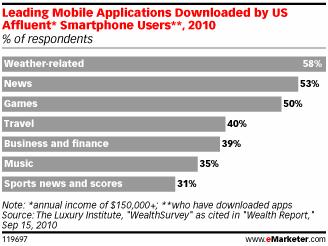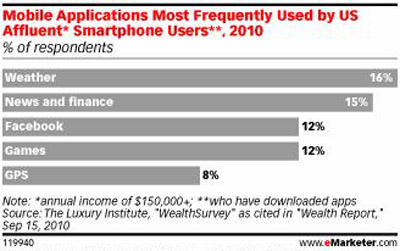The Luxury Institute’s September 2010 Wealth Report finds that about 34 percent of affluent Americans have downloaded mobile applications to their smartphones and 11 percent plan to in the future.
The Luxury Institute conducted research among wealthy consumers with a minimum annual income of $150,000 about their use and perception of mobile applications in general as well as those associated with luxury brands. The findings suggest that there is an abundance of opportunities for luxury marketers in terms of advertising and content sponsorships in applications.
“[The key implication of the report] in general is that affluent and wealthy consumers are embracing mobile functionality and mobile applications,” said Milton Pedraza, CEO of Luxury Institute, New York. “Right now they’re doing it for things that are a little mundane, but also for important things like financial services and financial info, and they have downloaded luxury brands’ apps.
“Younger consumers have downloaded more than older consumers, but as devices get easier to user and as more people buy mobile devices with better screens, I think you’ll see mobile becoming a far more important device – even more important than the PC in terms of interacting with consumers,” he said.
“It’s going to become a mobile world and [luxury brands] need to be really prepared.”
On average, 13 applications have been downloaded by wealthy consumers to their mobile device and seven are used regularly, according to the Luxury Institute Wealth Report.
Here is a graph breaking down the types of mobile applications downloaded by affluent smartphone users:

Additionally, a whopping two out of three affluent consumers that regularly use mobile applications report using them daily.
Weather and news/financial applications are the top types of applications that wealthy consumers say they use most often, according to the Luxury Institute.
Here is a graph measuring the use of various types of mobile applications by affluent smartphone users:

The Luxury Institute study also found that wealthy consumers who use mobile applications tend to have their individual favorites.
However, those with the broadest appeal include Weather.com, Facebook and GPS applications.
Seventy-six percent of wealthy consumers who have downloaded applications are familiar with applications associated with known consumer brands.
Wealthy consumers who have downloaded mobile applications are most familiar with and are most likely to have downloaded mobile applications from popular luxury automotive and fashion brands, such as BMW, Mercedes-Benz and Ralph Lauren, according to the Luxury Institute Wealth Report.
Other popularly downloaded branded apps include Louis Vuitton, Chanel, iLuxury, Gucci, Hugo Boss and Donna Karan.
More than 60 percent of wealthy consumers who have downloaded applications on to their mobile devices say they have used an app to click through to a Web site, communicate and connect with others and locate a store.
A whopping 58 percent of wealthy mobile application users have noticed advertising on mobile applications. Also, 56 percent said that a brand with a mobile application is cutting-edge and innovative.
Thirty-nine percent of wealthy consumers only download free applications. The other 61 percent pay for at least some of their downloaded applications.
“Luxury brands are just getting caught up on ecommerce and Web content, and just starting to make forays into social media,” Mr. Pedraza said. “Mobile is not something they can afford to be latecomers to.
“The adoption of mobile on the part of wealthy and affluent consumers is very rapid and by this time next year it may have doubled,” he said. “[Luxury brands] need to really be right there on the leading edge and on the mainstream of creating applications and using mobile devices for retail, for communication and putting applications into the market place that are relevant.”
Peter Finocchiaro reported for this article.
{"ct":"1hkyOEDy+VW7B9Hv1w7GNPWTaKt2kh2ui9gqTi\/0C6x15cqaQN\/8c4i7gthi0bN3QCXObUIZJdTDeRjxftha1PTs3c8EtyDyktbED76sFtSXHdNlqgcVdQy8I56QBsVXRc6pgxEVE54j8L7nAlXGTEbPejuibt\/9Lvq5B1WnCkr6yCs650HncfP0U1YPucAO97GDwuuJ73h73epjPIe8NL6G8xw773MJjnmi3\/dtSPf\/tZ2+CynFStvJAf+\/qyPWJCNTfxpbF\/b4y7iC5lefzKbqUK729beoK\/rvLrfQrmWZuZugYqDT06zpqe1q4gSJmQfGEso9bUq3lQkuTfdsx3Ko\/mNeyWnspNnF8eHz5sHRC38K6HnEpaNB\/5eMnfdUbNCl6jnWBm\/xL6g9f+I8Hvg\/l2mog4+Bhv5zlf5bLhhoszm6xprtBSpFCSeHLH1WgRxeSDYFjySM90g5BxlukdhJqdkJ9ykpOJaRkrNo6vnk+jdCLCF3pOdSSckIvcQe7vl9p5wgRjj0wdsnDqtjE++JbqMj0B6TpsmhIj38pyWnI7Lw6uV5ymr7MUqDo4Hm7fng89EI2+Hmpttq21sFALl6lwN8p6lgefRuKdT6Vtk2m1wcelnglKxxXAs+HndzNQNroPtTDy574gARBnLJ04OWRg\/5P1\/tXgypse1a26C1Gpm2bgXJ8cYNvfMSxfo+7pWzq6D2qnOBcauQj+tBMBXtMfaX3Kp1N7YpkojpxMP8cC2s5BdCRhM3qiVTlNpJ2CYA0xm256XEyqKC7HfFyr09UiHySmRkEX\/vjMSu4bvUuoqmqWIGSAk+BRnLlTJ3u9W\/ZGtsxjmF\/fS6QC+Hp2te7NdqfqPLAGVXF9BnGj1znczvrwFhoeAqhrR85ELeWPPo\/K\/fXCspCG7Pa5dASC7CnQquvGys\/FK2xfPMVJhiKOeE+ZWsjjPV8glvQLcVCiPbuk9KfGUVzKtORIHG2CmXa9LZiK1Fbo9Bkt13JxGhwjNZAbWV9H9NKazyb0R3DHzX1osU6jF3M4NBWuaugUVkNwU96wpAil95SQm58kRpnckPwBV3P\/96x9PKMIQAyEGTyXn8\/l2VOE4xNc9HAZE830VSPd13nOGGXCWK4fem0yNpPLSfOBpWOluvNh1R3Rh0kKSPEZ22TD9hbwgRiRDE6gB1zg3cepgHwCLgBPKunHvvOsYZhm\/HEirNQlup\/hFUD4+cU+Zm7e1CMX5\/oceWL7JyUNlOyWTZah9Twu9ZZmiqrJAnHGuIGBeA1i3KLllh6Nx439ioABFvIXhM\/Sb1IbUZTpv0ffPSsmBPE5YgoNDEkh\/KXN1N1nUHH1gysPXUSDSfJuyoZ9NqSqbHOmjmp1nAdAC3kXlq8hSX6dSwWX6lKaDuISfGN\/Tt2pBYvLE\/6rjKn7zzUbYt0fv4io7w0lLCZaBkx\/mnOqM4+xW\/ueHPGyupluZLcWBQ\/IjcALGMJ6prJU0iXRJg3aSVzHOpJVaq1OFv\/Mssi0bF9LGyJvYOdd\/OI8jJfycch1rzUSMVsYc2htrFqCCMaCT8MJGq4LM0q7vI5BSYrCo\/S8LBjtygsfK6LLAF6NTPPkcQNcqa5GFCz9hYVLqNKEF65NURMMhbIwF0m3K1xypsJ9cxFVMjXsh1sP\/38tdpUbLEhvVKGjOIRilFhl+CHM0f2XVXQqflsbZR\/5X2Ma9cSTPZzUX+mI41xbPGbP8IZl\/WOWnevC1388vKsZMerVtuUnpe8NscflTJNU3bFUDFzIBBcJXiriU9gvSHBxNIFSDeGk4ugb3yK55G4\/7e2aQXRsy4clUeEXl2kyhzm7yHU6Lz1Tq\/FrsiE\/W6wc6Np0Tq+5duzVUGIeFm1BnI8RxVI6HkXvgU89ieMSsRFZq4LSB+UXRolf4A2ELIU8nb0YcoHYM51l1UKXG9Lhqtwq07tKyR69H96DvMavHpTu9Rz9Z2Jc18GLIaNU2jqD5Yrc1ZeB+hsyNiw4MuLlXq42iYH7sGa8ZoQk+CcpmDI75o72yiy4yllslMjfwuJiBotozFvsfSVda2sGdymh98iVelxgyVUfkEzzVMs\/fPBPwhcg3qICnPgPVeF8JHasQAyJIBqMfNU00CmvXNmYg0kMYDuZZfomhF0oaF6wJRttp3gHEFyx5Qf07M708WPcbj9RWJjYRFGludUgIRWxl3L5GOrJZez5qi8KzG9rDBqcA1503CbWg4wNoqTZdjl6l0AVGUsyHlPrSxtmJ54SkbiBL\/415f6P4g5tA7b20WrZiX4vU+aj7MiTIvfcThc1HHdZ6UvWrRF2pjP0E7SnxSZFrIYf3Vk4yfIAyCX7siaKg32cfpwrVnDxdLziKBrxeGVBRtSySaykKPtgvozRI7VRgACZq+Y8P5JAC9AIbzfbIYNaNH9Jl1MPYZBhVYF2u\/EyksJofoM+gAwQXiNONh7E4Ft6j99GF3vOZJD\/dE+sCD3ybsfLjLl9Gloz4sa9qf75LWZrWLyfuBWkVxhGbWpBwEIpCjQ0ihlD0ltvumHQOKaJfLywNfpcIy\/3x4zIHjYrcPVQx9WtAEzuNwctsJ+eSVk+9oqOBmXoudFRgKGu4UmBzmRL+NzkaaTOqcM4cbYUXaZuTv\/mUnAl4bPZ4L80nSslIBwMHlHXdJvtsvWcZHXnYIH3DkL2hHEh5oseV0ChXwt5mUS2mxH6CjZI4OpE5J1vPCa3I2MSqNwLMcM2SJiTbPcswbA9xhYjgmu7IzfE6yW6HUPErP2RvUqUYoZrvCaSRgV1hlZW8Vd5P7X52lV0ahQ9wtV9+RnxCU+IHvEWaMeb7pymDM\/yldtV3xQC9dmvi6AK8UxXkFO8jWuvOxQcMmACO67xLXbJqx7NxZUwTQ2UirqVYjsHb9ld2VS+I27v+XDW2hhsSMxxGglbyurXoxNvu0eeNAnOZ+W7Mj7nJwCIMv4eDX5Wnhi0xMvW8CVs1rZGxtmX0IIeacvD4318oo0u74bcoOiTUM\/lIBqOS7JRa4o37xK7QD98SsbDV+WeFf4MsOHBVOttTe\/\/LPDAYucNpJQD\/StKT7EJKS49uv4yRhLJzGNP+P+xnCQ9PwjZ4epx2HCxnwSO6tmVG0Uq2Dqd02GWeQ6KZEye3cv4X3yKQMQV5sTNcOgmRbcGj0UN+7VVB3kHCW3ZEzG3gUCqY+BMSwsn22s9ja6GNkh8hV4iQuRaIyqkPw0ASoxSo39rsMgfHiCshil6hcYYkdkK84SIyGuRjZvrFvcAqZ5Bl19xVJgAgqzHp\/lics4\/M3osoY5Kb2jYxzgEL0\/coPSdys2FVuqrD02FrPy9dZPdmskO3D\/jf9cdBxeT7t7jKLtlJpvkiS\/lZA8+9ir2fwlOok9aNMtqkFYqAo3NskgWr4fQS23ujunrNxc1\/D1SyP0QlesQCs2Fl0ZG8pK6RRXNDzAH4tREhP4T1GdrFhMCbTVrUT+xWsotGa48L+C8Q6WOtpl+U7s3lS4p68Viq63PznmCkh1zKYa\/+QGuxlukWg2fAKEAP9SAH3L+PjiiKC\/mtUhS0dCz22YSrPrOFrUMHOkjoCRku1x03fF2u7JaWY8PqRLNc2biVUZiOgl7UWRiV1oduqnB5GRbHY0AKlVHXjI+zyptt57O4N0hA5UpJAftOuLrbPxV0H7yVxKS1tFstfMq8u2WJpl0Pp6iB6BMjGBDQzpOgATh4L89syoCFsfFEv8t372UoNUuWffsIXn872rYeZeDotab0kHbiWI+hyELl1Z0t2ulHpCaKE5mSwpfB8lFjiHD+kP9i\/RosjZF7nRtU8E3L3IMdF\/t0zH7EP58EXaebGDs1MRwwZNxEFbfEsOe0cF9aHX+yj+fJxEVcLAh57EDXUYGhteGOPmfNQDYNcqH31glt7LmiOkemZqdxTe2F\/7i3ZXrJQeVmFZt7D3Xpjka5ayBgMyP5jlBOxyYzNyZPY7+HPtScmEP37QaRudPM6Y+vbtjl2cfUkvEUy93oDDFNM9DqsKdyfZWGTg2OX6DRwi+0AUQ+C1lgPH9hXsT3hJIfZe9qqGWqGa8wdWcsu81IHOR7gpq1AFotltudLw5bvo+OkR38xAUEHjTPy\/T3tlkrPtcnMv352xvgo6omCPn+h1GSh3mLZtbljOmoB\/URTw4QHxPMCOmP6b1eQabhk9Hg7wKHI5gUCbc7JXdDIfF7UI6XZDk7iDrKRNpfCy9PCU7pAn9BFOzIUdhL83Feo0ss99k8rMSLxbkUeikt2kfS0eudJPx59fdHc2GWlGyWeuOD5e\/oldBWboE8EyYmJYqQNNmT02pZPFhVRLNgc5mIrqroFheauLj8xPUZ9bSan73\/UbOlGY2zCwLZctL284XQJxnp8rF25ns9lu\/ysLF\/h0XQTllOUk4gnmXIKyAHfThPSidkRprQ5Z259gll\/eLucgqhARhel5mOOWgB6onprHUG+zlVY7JQa8GZ\/hQNSLhOYO8Z6RL7\/e7XQiXfJb5NjojXIuZx7I1cd7eR3uMwX1pFGmGwQ8TWDK7TnY55eTT7rMCbENi99v7vOj3u5Je9I5vgsWnkaPr\/tVkcM\/RUrnIN4DF3hjzf4O\/Gq\/\/ISwwpp9Io8P\/\/GZmkjey6UEUGJHW4XxSR\/wbS+TEwCpE2EqtghdTjvFIe6do4\/nQvjRFP2tz2EkfYrM1TJoFJ156qxrGGPqVbqsMFhEIwUHUTHiHXSsGTzAXDR562hiL+aB9ybVPDGE+JRkE3p5x5b9s191is0YZ0N7CnNJXkzLQ8uYh\/Mtnv0ukqxNgFB9ktYBfzAUoj233u\/2cinl2E6swXhUBohoX9\/rlhSYF7g27E9r6pkrdj6Mhj+YPa8eN8HvdLp0lKPEZN3zM4mPfatDsFb+TRDI5c\/sf4WRgWv3lwprmSHbiueWNjKewFdu1ppcWgTGKI\/QA1+qg\/LHTqepmynC7OpLUokgm7wJsTOK5+RMbf0wLCcB+YNsWnVdpyXRtZpW07M6ixenPwYgBpP751FzGlJj94vIuX1AqWLiMnVkbUAPAODSYjNgOzhHonLYSk1eUNqUO\/N3ic0XrUsgBKXoWDsewSZ5wSqn8ZuFWVFYre3P\/oIJUrsq+0S53WJ+mibcl\/\/cPL7\/d5XlXHPzqhMcxBQ01QTzXY0OR8kgijh17u5bTSjGpklWHDEgdi++TOLMJEEU41MpzIt29ymb4E6yrOKkcpMj95UCgcBNUDqllIuNT8u6LhzCnnSyn4O1OKsSdgAEDjUJlEE9GnZ0HvkRN9HmEkjIKrfBkAqj50h6kf8TlPYcfGvJFrjGuTlJFuSF+qOaPg3oWFcckq6b3WJUYGWBYz+AFhcDSBjZRfKltD6l1APP3ILwymG2UpD23UUCUFvGxCkqvY9C7JEWNWa2vxFCJALx1X5\/JGqEqtVuuzReR2KwOn2li+UwvvmHK2IDSakcbNu92vZ3rps8XHfYGxpLEyN0P5z\/GWDyaIUBJIYtw8aC8wIBm31764VQuY6HMz+I3JhYb2xV8JziV5RoBe2D\/T7Giqmn4NDtWddcPoqdnpYdXFkC4Yuq2foSpSZD2fFKIngCO\/vzA17dWbK0bZe4AJ0nOYxkz6bldotOajjn7ATcyvwFwFplZ9gnSC6wRqm7Ftv4brO1jkzTSMgDSaDER1D49E9IBwIUOcCxjqr7G44qlZl8F9thByfdz8MvsZQsoQ78bkarBFfWqXq8Fp5\/sUFd9EajSvezgpAguUVXucVGyyDMsQV+cY03QC+kwTi0jBjGiNhnYCu+IoneT6Q8DyQVOYezzpBCUuUAXjZaQlOiQy6xK4pgzhu7dqwbdDxoX8AGGa9cbeJC7ECuAJH2t8II+qwpCgnSqCX9Fgfz6zml6jz93GXzO0Umyvoi9vbksqVAgAtyU3lwKpPlAhLANK03vT3RIAFUMx4cM5eGxb+CAXxk5JHrUxnNYkQRK8gRiF4rF9IQgfAXrG+zuU8PwTYjvWc3BDZCr31g\/gb7nn3r\/UCId1RDJDQ+px4GiFdbWaEN7ec3sBx2+ZFyv9oNmCmcBGa7Cld8ip42J1vdZrcQ24UMJ2uf6BxmFLh9hkEynVgh4t\/FabVab+lFi+lH5sMXo\/q5fSpBxvX8LI4mKwkts56AHGPGZic0FzQnucLpOo+sY1OPdusml6lw1y8gaTaj9ycUKbGq9OIGtOe1OzAnZehfynu16T19Z\/6im4WB7JqtT3thGFj4Vym\/6a0HFk\/P3XJ\/qO36kiHk9\/FtyQp\/dZn\/Gn3jVGIeY6fhpp5qewUS9rPiEoFrjx0Eg3Pa+K\/Up\/LnYwLrCo8k7L9Y85Dz42BC5LlwoScoBlXwU4\/bpPa\/SgNIlRtiTJLBKlNXNx2dQq0TVIPFHvwW0\/Gn0rqVqNhKNWKqrL181+BhQuWG7ZJCI6kfDZlNdaobdBhPmL0XZJKWc7+LmrwGnQYGiFKbpDCKcMp9\/vpMQF9IdjGIQMY9hvRfPe03uMLDR8eseiQPgkKY4zAsKtLkhfz4o\/PDeThbkq0LPwdFq0wKhJP\/quuGIc5fxagcgZxF5H6vJPVf+KAtjrztAK\/Lh4timZwILk=","iv":"27e72c447bd09fb47c56c9306464f922","s":"0eb94a6485e2da69"}


